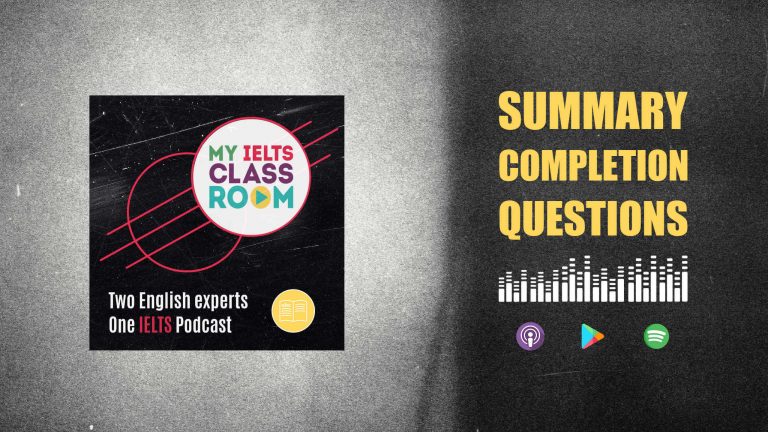
IELTS Summary Completion Questions
IELTS Summary Completion Questions
IELTS Summary Completion questions may be my favourite type of question in the IELTS exam. They are quick and often relatively easy to answer and give you the opportunity of grabbing 3 or 4 quick points in a the space of one short paragraph. If you compare that to Multiple Choice or Headings Match questions, which can require you to read and interpret an entire paragraph for just one point, you can see why I like them so much!
Today, Nick and I look at the two types of IELTS Summary Completion questions to show you how the writers “hide” the answers and how you can use this to help you find them. If you have ever wanted to see inside the horror of an english exam writer’ mind, then this is the episode for you!
Below, you can find a summary of the episode, which includes all of the links to useful materials and the times of each part of the discussion (so you can go directly to the part you want to listen to) 🚀
Subscribe to My IELTS Classroom podcast on Apple podcasts here ![]()
![]() Subscribe to My IELTS Classroom on Google podcasts here
Subscribe to My IELTS Classroom on Google podcasts here
Podcast Summary: IELTS Summary Completion Questions
Although today we are going to look specifically at IETS Summary Completion questions, you should know that here are actually FIVE types of possible completion questions that can found in the GT and Academic versions of the test:
- Sentence completion
- Note completion
- Flow chart completion
- Summary completion
- Diagram completion (usually only in the Academic IELTS test)
Now, there are daintily a few small differences between the completion activities. For example, Diagram Completion questions can appear in a different order than the passage (so you may find the answer for question 24 before you find the answer for question 23) whereas Sentence Completion always follow the order of the text, and Note Completion questions may have headings to help you.
However, in general, all five completion questions ask you to do the same thing
to complete sentences using a word or words taken directly from the passage
Let’s repeat that – you must complete the sentence or phrase using a word that is taken directly rom the passage. It is very important that you do not change the word that you find in the text. i.e. you should just copy it. If you think that the word you have chosen needs to be changed to complete the sentence, then it is NOT the right answer!
Also, be careful when you are copying the word onto your answer sheet. If you spell the word incorrectly, you will lose points even if it is the missing word
How many words can you use to complete the sentence?
Good question! Usually it is one, but you may be asked to use up to three words to complete once space. However, if the instructions says “Use no more than two words” it does NOT mean that ever answer is two words. All you know is that AT LEAST ONE ANSWER will require two words. The rest may all be one.
Also, if you think that the answer is two words, you must use two words that appear together in the text.
For example, if you think that the answer is “large pink elephant” then you can write the answer “pink elephant” or “large pink” as these appear together in the text, but not “large elephant” (as these words are separated by “pink”.
What type of words should I be looking for?
Just like completion activities in listening Part 4, 90% of the time, the missing word will be a noun. However, you should think about the type of noun that is missing. To do this, you should look at the words before and after the space:
- singular nouns will be preceded by the indefinite article (a / an) and be followed by a singular verb (for example “is” or “has”)
- plural nouns may be preceded by a quantifier (like “some” or “many”) nd be followed by a plural verb (for example “are “, “were”, or “have”)
- uncountable nouns may be preceded by a quantifier (like “much”) and again may be followed by a singular verb
There is a small chance that you will be asked to look for a verb or an adjective, but in recent Cambridge Books the focus has been heavily on nouns as IELTS has shifted the reading exam away from testing grammar and towards testing meaning.
Would you like expert help to improve your IELTS reading score?
We offer a 5-day intensive course for IELTS test-takers every month that covers all aspects of reading from how to approach every type of question to how to “read one, read well” to manage your time more effectively. Even better, with every course having no more than 8 students and being run by an ex-examiner, you will be getting personalised advice that is guaranteed to help you to improve your score.
Find out more about the course and how it can help you hit your target score here.
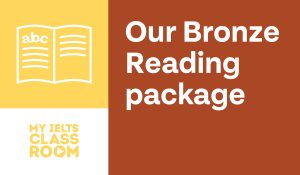
The Two Types of IELTS Summary Completion
It is important to note that there are actually two types of IELTS summary completion questions. The first is like we have just described. You will have a short summary of part of the text that has some words missing.

You will need to complete the summary using words from the passage. However, the way that the summary is written offers vital clues as to where you will find the answer (as we will see in today’s episode)
- If the summary is shown in ONE paragraph, that usually indicates that you will also find all of the answers in ONE paragraph. IELTS does not make it difficult to identity the paragraph with the answers. All you will need to do is search for key words that match the heading of the summary in the text. These almost always appear in the first line of a paragraph. These questions are GREAT as you may be able to find 3 or 4 answers in one short paragraph – in other words, these are quick easy points.
- If the summary is divided into TWO paragraphs, then this usually indicates that you will find the answers in more than one paragraph. It might be two but be prepared to look for the answers over 3 or even 4 paragraphs. In this case, you will need to look not only at the heading of the summary but the key words inside the summary to locate the right place in the passage to find the answers.
The second type of summary question is similar. You will again be given one or two paragraphs that summarise part of the passage with missing words, but this time you are also given a box below the summary that contains SYNONYMS of the missing words. Your job this time will be to locate the missing word in the passage and then find its synonym in the box.
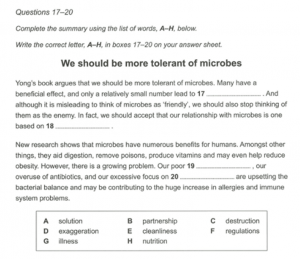
Be careful – the answer to these questions is not the WORD in the box but the LETTER next to the word (i.e. A, B, C, D, E). Make sure you write this on your answer sheet. There are also extra words that are not needed, so be careful that the word you choose matches the word in the text most closely.
Even though in the second type of summary completion you can see the possible answers and there is an opportunity to guess (which we do NOT recommend that you do), I think that these are much more difficult to answer.
You now have an extra “step” in the process of completing the summary – finding the synonym. If your lexis is not strong, you may find it difficult to find the word in the box that 100% matches the word that you have found in the text.
Enjoying this lesson? Why not listen to our guide to T/F/NG questions when you have finished?
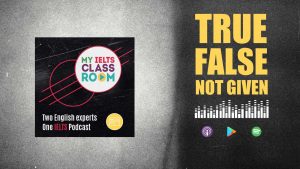
How should you approach IELTS summary completion questions?
I think that the best way to show you how to approach IELTS Summary Questions is to first show you how exam writers create them. Once you know the “tricks” that they use, you should find this type of question relatively easy to answer. These questions are actually quite difficult to write as I have to make it possible to find the answer but at the same time hide the answer so that not all students can find it! What can I use to do this?
Synonyms and Paraphrasing
The first thing that I will do as an exam writer is replace words from the text with synonyms. A strong reader will recognise these and know that they are in the right place in the passage. Let’s take this passage for example. I have decided that I want to remove the word “social” form the summary and have highlighted in the words that I think that I can find synonyms for when I write the summary
A Brief History of the English Language (Original)
Where it all started. While English grammar does play a part when taking courses to improve English overall, it is but a small part of the overall curriculum where one becomes immersed in a history that was partly influenced by myths, battles, and legends on one hand, and the everyday workings of its various social layers on the other.
Now look at the summary. How did I paragraph the highlighted words?
A Brief History of the English Language (Summary)
Grammar may be one aspect of studying English, but its place in the whole curriculum is relatively minor when we consider the impact of folktales and war and day to day life at different ___________ levels.
As you can see, I have not used synonyms for every word (grammar and curriculum have remained the same) and some parts of the text have been removed altogether (when taking courses / immersed in history / legends) but this is already starting to look like a good summary question as the main idea of the sentence is still clear and students will need to recognise the synonyms as they read. However, I don’t think that this summary is finished.
Changing the Word Order
I think that this question would be far too easy for most IELTS students. Why? Because the order of the summary is exactly the same as the original text. To make the question more difficult, I need to change the order that some of the information is presented to “confuse” the student.
A Brief History of the English Language (Original)
Where is all started. While English grammar does play a part when taking courses to improve English overall, it is but a small part of the overall curriculum where one becomes immersed in a history that was partly influenced by myths, battles, and legends on one hand, and the everyday workings of its various social layers on the other.
A Brief History of the English Language (Summary – more difficult)
Grammar may be one aspect of studying English, but its place in the whole curriculum is relatively minor when we consider the day to day life at different ___________ levels and the impact of folktales and war.
What I have done here is not revolutionary, but simple swapping the order of the two items at the end of the sentence is often enough to confuse the weak students. If we wanted to, we could go a step further and change the order of the entire sentence:
A Brief History of the English Language (summary – very difficult)
If we take into consideration the day to day life at different ___________ levels and the impact of folktales and war, then grammar is a relatively minor aspect of studying English.
Notice how I have also removed some of the less important detail here to make a much more difficult summary. This would be a question for higher-level students, but the meaning of the sentence is the same even though the order that the information is presented is not different. Plus, I have left enough synonyms to help the student understand that they answer is close in the sentence!
Simple ways that examiners can change the order of information is to change the active to the passive, change the order that information is presented in a list, or move items from the end of a sentence to the start.
How does these tricks help me answer IELTS Summary Completion questions?
Well, now you know that the writer is using synonyms, you should use those like breadcrumbs to follow the passage and find the answer in the text.
In other words, synonyms are basically signals that you are in the right place to find the answers
However, once you find the synonyms, you should focus on the MEANING of the sentence you are trying to complete as you may need to go forward or back in the text to find the missing word. Students who rely on scanning almost never go back, which is why I don’t that that this is the right technique for this type of question. You want to start reading the summary from the beginning and matching key words from the passage as you go. This should basically “lead you” to the missing words
Let’s practice with this summary from of my favourite IELTS reading texts “Saving Bugs to Find New Drugs”. You can listen to the episode to find the answers.

Discover the secret to writing a Band 7.0+ essay
Then download a copy of our FREE e-book, which explains the most common errors made by test-takers and how you can avoid them. Just click here for your copy.
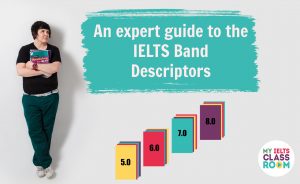
What about IELTS summary questions that ask you to choose the answer from a box?
As I mentioned previously, the method that we use for box summaries is more or less the same. We will follow the synonyms to find the word that fits the space in the passage, but then we will need to find a synonym for that word in the box.
However, although this extra step may make this type of summary more difficult, the words in the box may actually help us to narrow down the possible answers. Let’s look at the possible answers for the summary to “We should be more tolerant of microbes”. What type of words are can you see in the box? Yes, they are all nouns, but are the same type of nouns? No!
- some are countable nouns (solution / illness / partnership / exaggeration)
- some are uncountable nouns (cleanliness / nutrition / destruction)
- and one crazy word is plural (regulations)
In some summaries, recognising that the words are different may help you narrow down the possible answers for each space. The key to find the missing words though is more or less the same as for the original type of summary completion – we follow the trail of synonyms until we find a word that fits the space grammatically and meaningfully. Then, we simply look fo or its synonym in the box.
Let’s practice with this summary from “I contain Multitudes”. Again, you can listen to the episode to find the answers.
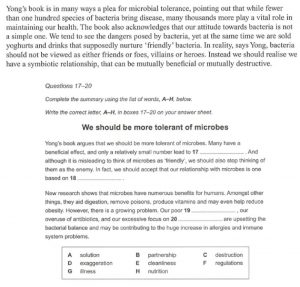
Well, those were IELTS summary completion questions. I hope that after this lesson you have learned to love them as much as I do. Tell me in the comments if it did – we always love to hear your feedback!
